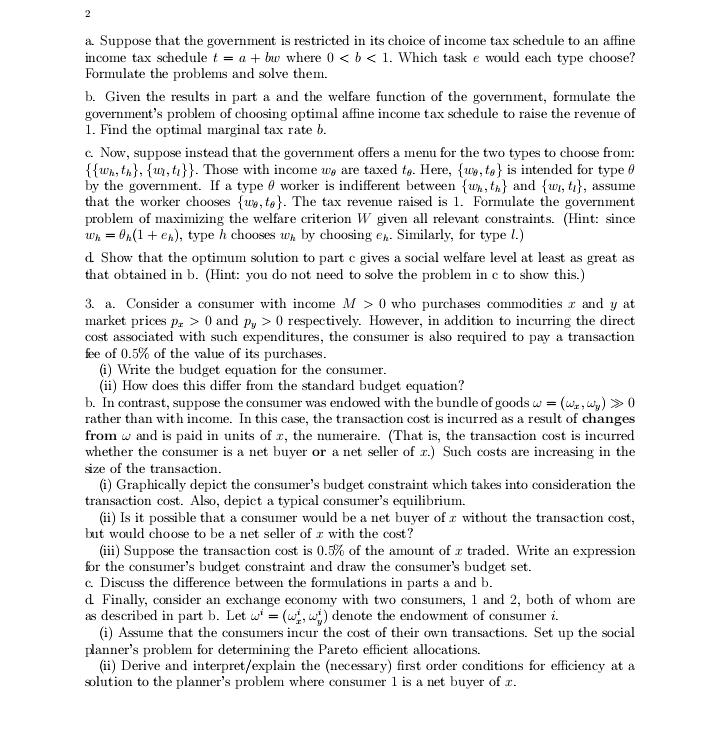
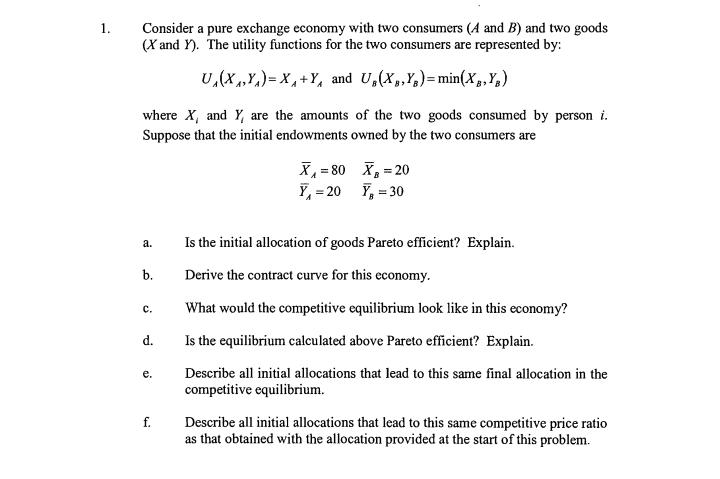
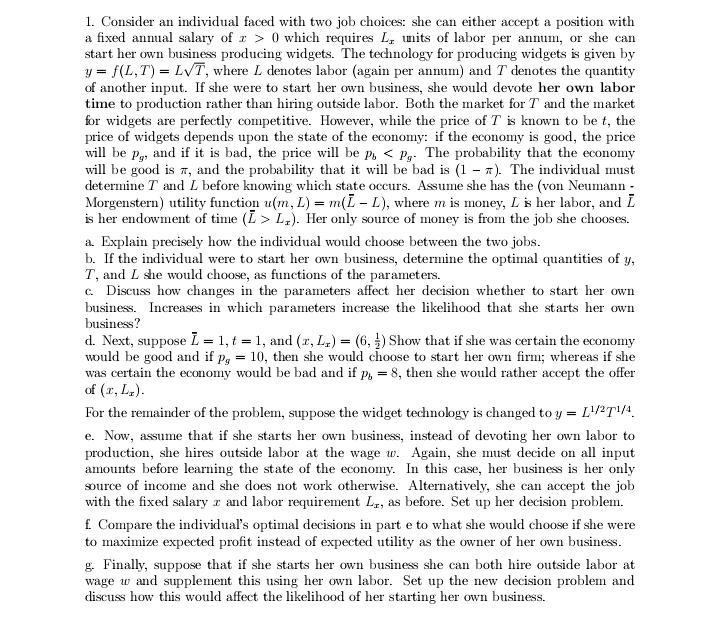
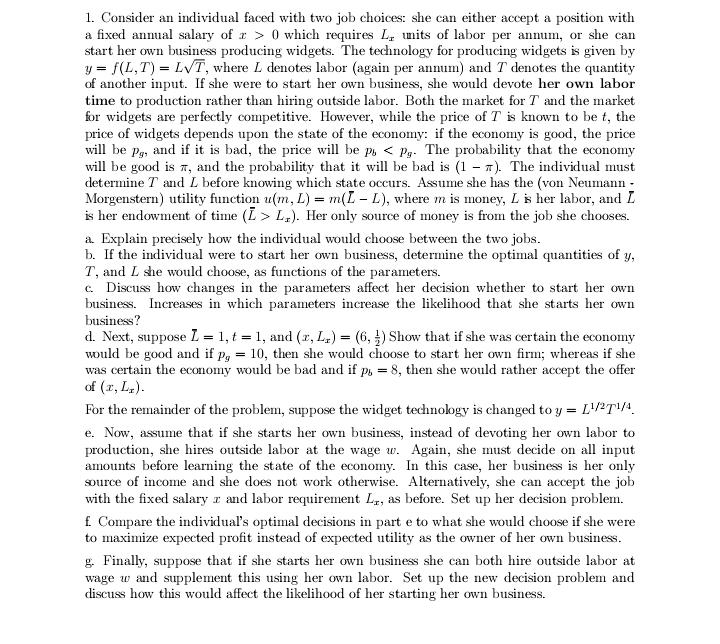
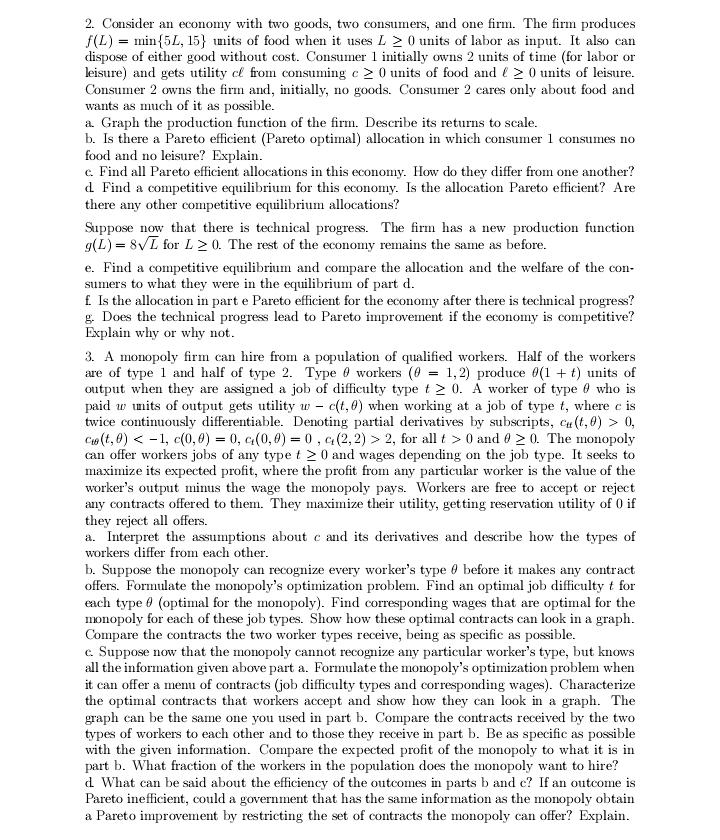
2 a. Suppose that the government is restricted in its choice of income tax schedule to an affine income tax schedule { = a + ba where 0 0 who purchases commodities r and y at market prices p, > 0 and py > 0 respectively. However, in addition to incurring the direct cost associated with such expenditures, the consumer is also required to pay a transaction fee of 0.5% of the value of its purchases. (i) Write the budget equation for the consumer. (ii) How does this differ from the standard budget equation? b. In contrast, suppose the consumer was endowed with the bundle of goods w = (w,,wy) $ 0 rather than with income. In this case, the transaction cost is incurred as a result of changes from w and is paid in units of r, the numeraire. (That is, the transaction cost is incurred whether the consumer is a net buyer or a net seller of z.) Such costs are increasing in the size of the transaction. (i) Graphically depict the consumer's budget constraint which takes into consideration the transaction cost. Also, depict a typical consumer's equilibrium. (ii) Is it possible that a consumer would be a net buyer of r without the transaction cost, but would choose to be a net seller of r with the cost? (iii) Suppose the transaction cost is 0.5%% of the amount of a traded. Write an expression for the consumer's budget constraint and draw the consumer's budget set. c. Discuss the difference between the formulations in parts a and b. d Finally, consider an exchange economy with two consumers, 1 and 2, both of whom are is described in part b. Let w' = (wj, w;) denote the endowment of consumer z. (i) Assume that the consumers incur the cost of their own transactions. Set up the social planner's problem for determining the Pareto efficient allocations. (ii) Derive and interpret/explain the (necessary) first order conditions for efficiency at a solution to the planner's problem where consumer 1 is a net buyer of r.1. Consider a pure exchange economy with two consumers (4 and B) and two goods (X and 1). The utility functions for the two consumers are represented by: U.(X,,Y.)= X, +Y, and U,(X,,Y, )= min(X,, Y,) where X, and Y are the amounts of the two goods consumed by person i. Suppose that the initial endowments owned by the two consumers are X, =80 X, = 20 Y, = 20 Y, = 30 a. Is the initial allocation of goods Pareto efficient? Explain. b. Derive the contract curve for this economy. C. What would the competitive equilibrium look like in this economy? d. Is the equilibrium calculated above Pareto efficient? Explain. e. Describe all initial allocations that lead to this same final allocation in the competitive equilibrium. f. Describe all initial allocations that lead to this same competitive price ratio as that obtained with the allocation provided at the start of this problem.1. Consider an individual faced with two job choices: she can either accept a position with a fixed annual salary of > > 0 which requires L, units of labor per annum, or she can start her own business producing widgets. The technology for producing widgets is given by y = f(L,T) = LVT, where L denotes labor (again per annum) and T denotes the quantity of another input. If she were to start her own business, she would devote her own labor time to production rather than hiring outside labor. Both the market for 7 and the market for widgets are perfectly competitive. However, while the price of 7 is known to be t, the price of widgets depends upon the state of the economy: if the economy is good, the price will be po, and if it is bad, the price will be p, L,). Her only source of money is from the job she chooses. a. Explain precisely how the individual would choose between the two jobs. b. If the individual were to start her own business, determine the optimal quantities of y, T, and & she would choose, as functions of the parameters. c. Discuss how changes in the parameters affect her decision whether to start her own business. Increases in which parameters increase the likelihood that she starts her own business? d. Next, suppose L = 1, t = 1, and (r, L,) = (6, :) Show that if she was certain the economy would be good and if p, = 10, then she would choose to start her own firm; whereas if she was certain the economy would be bad and if p, = 8, then she would rather accept the offer of ( r, LY). For the remainder of the problem, suppose the widget technology is changed to y = [1271/4. e. Now, assume that if she starts her own business, instead of devoting her own labor to production, she hires outside labor at the wage w. Again, she must decide on all input amounts before learning the state of the economy. In this case, her business is her only source of income and she does not work otherwise. Alternatively, she can accept the job with the fixed salary r and labor requirement Ly, as before. Set up her decision problem. f. Compare the individual's optimal decisions in part e to what she would choose if she were to maximize expected profit instead of expected utility as the owner of her own business. g. Finally, suppose that if she starts her own business she can both hire outside labor at wage w and supplement this using her own labor. Set up the new decision problem and discuss how this would affect the likelihood of her starting her own business.1. Consider an individual faced with two job choices: she can either accept a position with a fixed annual salary of r > 0 which requires L, units of labor per annum, or she can start her own business producing widgets. The technology for producing widgets is given by y = f(L,T) = LVT, where L denotes labor (again per annum) and T denotes the quantity of another input. If she were to start her own business, she would devote her own labor time to production rather than hiring outside labor. Both the market for 7 and the market for widgets are perfectly competitive. However, while the price of 7 is known to be t, the price of widgets depends upon the state of the economy: if the economy is good, the price will be py, and if it is bad, the price will be py L,). Her only source of money is from the job she chooses. a. Explain precisely how the individual would choose between the two jobs. b. If the individual were to start her own business, determine the optimal quantities of y, T, and L she would choose, as functions of the parameters. c. Discuss how changes in the parameters affect her decision whether to start her own business. Increases in which parameters increase the likelihood that she starts her own business? d. Next, suppose Z = 1, t = 1, and (r, L,) = (6, }) Show that if she was certain the economy would be good and if p, = 10, then she would choose to start her own firm; whereas if she was certain the economy would be bad and if p, = 8, then she would rather accept the offer of (1, LI). For the remainder of the problem, suppose the widget technology is changed to y = [1/2T1/4. e. Now, assume that if she starts her own business, instead of devoting her own labor to production, she hires outside labor at the wage w. Again, she must decide on all input amounts before learning the state of the economy. In this case, her business is her only source of income and she does not work otherwise. Alternatively, she can accept the job with the fixed salary r and labor requirement Ly, as before. Set up her decision problem. f. Compare the individual's optimal decisions in part e to what she would choose if she were to maximize expected profit instead of expected utility as the owner of her own business. g. Finally, suppose that if she starts her own business she can both hire outside labor at wage w and supplement this using her own labor. Set up the new decision problem and discuss how this would affect the likelihood of her starting her own business.2. Consider an economy with two goods, two consumers, and one firm. The firm produces f(L) = min {5L, 15} units of food when it uses L 2 0 units of labor as input. It also can dispose of either good without cost. Consumer 1 initially owns 2 units of time (for labor or leisure) and gets utility of from consuming c 2 0 units of food and / 2 0 units of leisure. Consumer 2 owns the firm and, initially, no goods. Consumer 2 cares only about food and wants as much of it as possible. a. Graph the production function of the firm. Describe its returns to scale. b. Is there a Pareto efficient (Pareto optimal) allocation in which consumer 1 consumes no food and no leisure? Explain. . Find all Pareto efficient allocations in this economy. How do they differ from one another? d Find a competitive equilibrium for this economy. Is the allocation Pareto efficient? Are there any other competitive equilibrium allocations? Suppose now that there is technical progress. The firm has a new production function g(L) = 8VL for L 2 0. The rest of the economy remains the same as before. e. Find a competitive equilibrium and compare the allocation and the welfare of the con- sumers to what they were in the equilibrium of part d. f Is the allocation in part e Pareto efficient for the economy after there is technical progress? g. Does the technical progress lead to Pareto improvement if the economy is competitive? Explain why or why not. 3. A monopoly firm can hire from a population of qualified workers. Half of the workers are of type 1 and half of type 2. Type 0 workers (0 = 1,2) produce 0(1 + () units of output when they are assigned a job of difficulty type t 2 0. A worker of type 0 who is paid w units of output gets utility w - c(t,#) when working at a job of type t, where c is twice continuously differentiable. Denoting partial derivatives by subscripts, ca (t, 0) > 0, Co(t, 0) 2, for all t > 0 and 0 2 0. The monopoly can offer workers jobs of any type t 2 0 and wages depending on the job type. It seeks to maximize its expected profit, where the profit from any particular worker is the value of the worker's output minus the wage the monopoly pays. Workers are free to accept or reject any contracts offered to them. They maximize their utility, getting reservation utility of 0 if they reject all offers. a. Interpret the assumptions about c and its derivatives and describe how the types of workers differ from each other. b. Suppose the monopoly can recognize every worker's type 0 before it makes any contract offers. Formulate the monopoly's optimization problem. Find an optimal job difficulty t for each type 6 (optimal for the monopoly). Find corresponding wages that are optimal for the monopoly for each of these job types. Show how these optimal contracts can look in a graph. Compare the contracts the two worker types receive, being as specific as possible. c. Suppose now that the monopoly cannot recognize any particular worker's type, but knows all the information given above part a. Formulate the monopoly's optimization problem when it can offer a menu of contracts (job difficulty types and corresponding wages). Characterize the optimal contracts that workers accept and show how they can look in a graph. The graph can be the same one you used in part b. Compare the contracts received by the two types of workers to each other and to those they receive in part b. Be as specific as possible with the given information. Compare the expected profit of the monopoly to what it is in part b. What fraction of the workers in the population does the monopoly want to hire? What can be said about the efficiency of the outcomes in parts b and c? If an outcome is Pareto inefficient, could a government that has the same information as the monopoly obtain a Pareto improvement by restricting the set of contracts the monopoly can offer? Explain
















